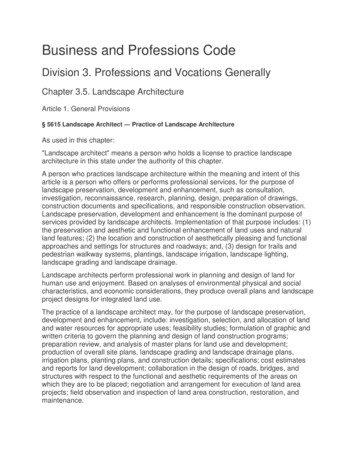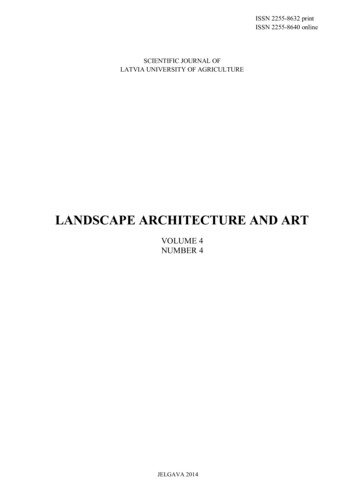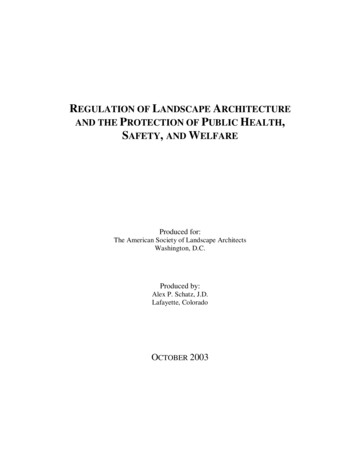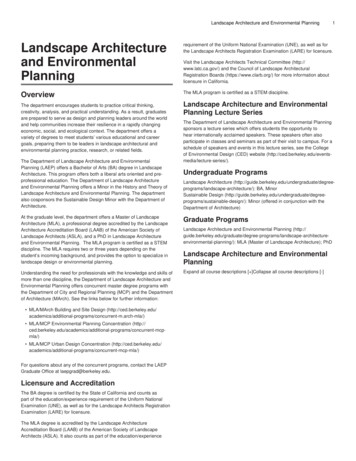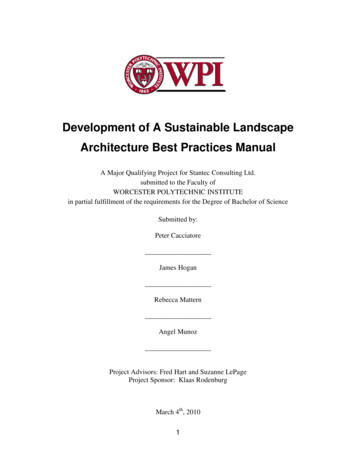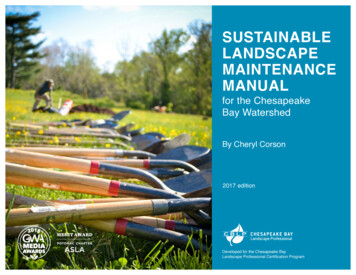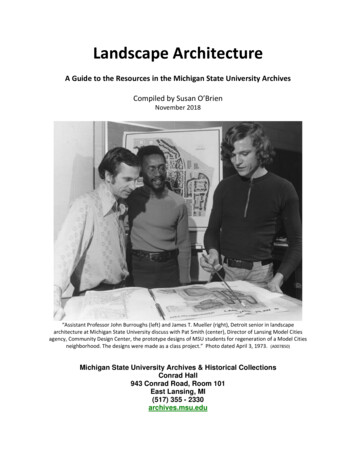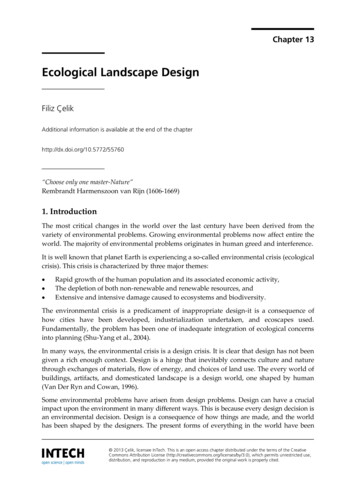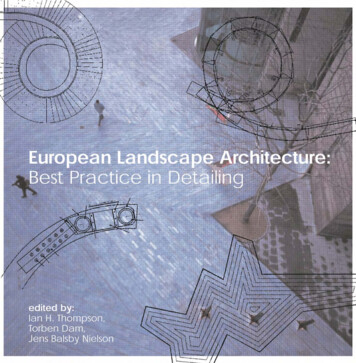
Transcription
European Landscape ArchitectureThis is an important new book about landscape construction and good detailed design. It is not a bookof standard details in landscape architecture, nordoes it give the reader step-by-step instructions;instead it highlights how important it is to considerdetail in the creative process, showing that goodpractice in detailing is as integral to successfuldesign as an exciting concept or striking site plan.The book features case studies of recent landscape architectural projects in nine European countries, including the Peace Garden in Sheffield, theHarbour Park in Copenhagen, a motorway servicestation in France, a guest house garden in Hungary,a cemetery in Munich and the new Botanic Gardensin Barcelona. Each project has been chosen for itsexemplary good practice in construction detailingand is demonstrative of how a strong overall concept can be expressed through well-designed detailto create convincing design.European Landscape Architecture draws togethera team of leading professionals and academics inthe field of landscape architecture. The case studies are well-illustrated with photographs and manyoriginal construction drawings running alongsidethe text. This will be a valuable source book forstudents and practitioners alike, as well as beingof interest to researchers with an interest in theprocess of design.Jens Balsby Nielsen was Associate Professor at theUniversity of Copenhagen from 1998–2005 wherehis main subjects were landscape planning, management, and landscape architectural detailing and construction. In 2005 he became a landscape advisor inthe Danish Palaces and Properties Agency.Torben Dam has been an Associate Professor at theUniversity of Copenhagen since 1993. Torben is theauthor of books about garden design, quality standards and hard surfaces in landscape architecture. Hismain areas of teaching and research are in detailingand construction in landscape architecture.Ian Thompson is Reader in Landscape Architectureat Newcastle University. A chartered landscapearchitect and town-planner, he spent thirteen yearsin practice before joining the teaching staff in theSchool of Architecture, Planning and Landscape in1992. He is editor of the international peer-reviewedjournal Landscape Research and the author ofseveral books including Ecology, Community andDelight (Spon Press, 1999) which won a LandscapeInstitute Award in 2001 and The Sun King’s Garden(Bloomsbury, 2006), a narrative history of the creation of the gardens of Versailles.
First published 2007 by Routledge2 Park Square, Milton Park, Abingdon, Oxon, OX14 4RNSimultaneously published in the USA and Canada by Routledge270 Madison Avenue, New York, NY10016Routledge is an imprint of the Taylor & Francis Group, an informa business 2007 Jens Balsby Nielsen, Torben Dam and Ian Thompson, selection and editorial matter;individual chapters, the contributorsThis edition published in the Taylor & Francis e-Library, 2007.“To purchase your own copy of this or any of Taylor & Francis or Routledge’scollection of thousands of eBooks please go to www.eBookstore.tandf.co.uk.”All rights reserved. No part of this book may be reprinted or reproduced or utilised in any formor by any electronic, mechanical, or other means, now known or hereafter invented, includingphotocopying and recording, or in any information storage or retrieval system, without permission in writing from the publishers.British Library Cataloguing in Publication DataA catalogue record for this book is available from the British LibraryLibrary of Congress Cataloging- in-Publication DataA catalog record for this book has been applied forISBN 0–203–62299–5 Master e-book ISBNISBN10 0-415-30736-8 (hbk)ISBN10 0-415-30737-6 (pbk)ISBN13 978-0-415-30736-9 (hbk)ISBN13 978-0-415-30737-6 (pbk)ISBN13 978-0-203-62299-5 (ebk)
European Landscape ArchitectureBest practice in detailingEdited byJens Balsby Nielsen, Torben Dam and Ian Thompson
xiIllustration credits1IntroductionJens Balsby Nielsen, Torben Dam and Ian Thompson9DenmarkTorben Dam and Jens Balsby Nielsen43IrelandSue Jackson67FranceEmma Jonasson81GermanyIngrid Schegk and Sabrina Wilk119HungaryKinga Szilágyi153The NetherlandsBoudewijn Almekinders and Ad Koolen183SpainMarti Franch213SwedenAnn Bergsjö237The United KingdomIan Thompson263Notes267Index
ForewordDesign proposes ideas but it is through the mediumof landscape detail that these ideas are projectedas a material reality on site. The art of this activity,and I need to declare immediately that it is a veryinventive, subtle and robust art-form, lies in theprocesses of detail design – the act of detailing bythe landscape architect and the subsequent evolution and elaboration over time and by others of theresulting constructed landscape detail elementsand forms. If landscape architecture is to continueto advance its knowledge base as a series of cultural practices and a pragmatic art form of the highest level, design practitioners and teachers mustpay due care and attention to advancing the practiceof landscape detail as the core of contemporarylandscape design.Three crucial areas of work need to be carried out bylandscape researchers and academics regarding thebroader subject of landscape technology, construction and detail design. These are detail durability,the preparation of a history of landscape technology and, finally, regional case studies in landscapedesign detail. The first area, durability, has becomeof increasing significance to the landscape architecture profession as issues of sustainability, diminishing natural material resources and accountabilityrequired by clients and municipalities for constructed landscape design projects over time. The secondarea, on the history of landscape technology, hasregrettably still not received adequate attention bylandscape historians or theorists and still remainsa productive area of the landscape field in need ofdevelopment. Finally, with this publication focusingon the European experience of landscape detail anddetailing practices, the third area of work takes asignificant step forward in addressing the issues oflandscape detail across national and geographicalboundaries. In this book and in the cases studiesthat are illustrated here, the European landscapedesign community has taken up the task of offeringcritical commentary on contemporary detail practices and projects within their national landscapes.This is both a timely and significant task as thedevelopment and implementation of contemporarylandscapes and conversely, it should be noted, thedemolition and eradication of many more recentdesign works, continues with little pause. In addition, the geographical and cultural complexities ofthe national practices demonstrated here presentan antidote to globalization, homogeneity and lackof specificity in detail design. This is therefore abenchmark publication by the editors Jens BalsbyNielsen, Torben Dam and Ian Thompson in theevolution of landscape architectural practice andscholarship.The case studies that occupy the greater part ofthis book illustratate landscape projects as livingdynamic processes of design, with their resultantvii
Foreworddead-ends, backtracking, leaps of imagination andperiods of creative design synthesis.The case studies do not, as the editors point out,resemble a set of guidelines or rules that will automatically result in successful details in the future(we may, however, care to measure the notionof 'success'). That is not the nature of landscapedesign or that of landscape detail. It still requiresindividuals to have developed individual designtalent with the capacity to work productively inthe landscape field in whatever country or countries they are commissioned to work. Nor do theyabsolve the designer of having to grasp the totalrange of knowledge and skills in all other areas oflandscape architecture design, technology and construction practices.Instead, they provide a way of understanding landscape design through its detail, and, at the sametime, a way of looking at landscape detail throughdesign. In this, the purpose is to project landscapedetail beyond its current role as a complement toother parts of the landscape design and planningprocesses, and to establish it as an identifiablesubject on its own. This is a subject deeply concerned with the intellectual activity of design, bothas a daily form of practice and a personal aestheticlanguage.viiiIt is also a way of rediscovering what has alreadybeen recognized in the landscape design work ofprevious historical periods, but today continuesto elude our full appreciation. Making landscapedetail form as a design activity requires a lifetimeinvestment of energy, resources and patience fromany designer. The notion of commitment to seriousdetail investigation requires an obsessive mind,while also giving broad attention to the particulardesign challenges of landscape detailing, a clearintellectual focus, and a deep understanding ofdesign history with as much practical site experience in varied cultures and climates as any designercan muster in a professional life time.In return a built form is produced which is intricateyet strong in its resolution and execution, an art formcombining materials, ideas and meaning, which issimultaneously poetic and pragmatic. In short, itdisplays the practical dimensions and creative possibilities of landscape design detail. It is hoped thatthis publication will be the first of many.Niall KirkwoodProfessor of Landscape Architecture andTechnology Chair and Program Director,Department of Landscape Architecture Director,Center for Technology and Environment at theHarvard Graduate School of Design
AcknowledgementsThis book has been long in the making and haspassed through many hands. The editors would liketo thank the authors of the various chapters andall of those practitioners who assisted by agreeingto be interviewed and by supplying drawings andimages of their work.At Routledge we would like to thank CarolineMallinder for commissioning the book, MichelleGreen and Jules Mohm for their help along theway and Katherine Morton for bringing a difficultproject to completion. Susan Dunsmore was anenthusiastic, entertaining and amazingly quick copyeditor. Gavin Ambrose came up with a crisp designto complement the quality of the work portrayed.The typesetter Alex Lazarou juggled the text andcaptions around until it all seemed to work. Last,but by no means least, we would like to thankHavekulturfonden, the Danish foundation whichmade a generous contribution towards the cost ofthe colour reproduction. Like a designed landscape,this book is a collaborative effort. Credit to you all.ix
ContributorsBoudewijn Almekinders is a principal of OKRALandscape Architects, Utrecht, and a tutor in theDepartment of Landscape Architecture at LarensteinUniversity, Amsterdam.Ann Bergsjö is an Associate Professor in theSwedish University of Agricultural Sciences (SLU),Alnarp, where she teaches courses in landscapearchitecture and construction detailing. She was previously employed by White, Stockholm, a Swedisharchitectural practice.Marti Franch has a landscape architecture practicebased in Girona, north of Barcelona. He is a graduate of Greenwich University, and a part-time lecturerat the Polytechnic University of Catalonia.Sue Jackson is a chartered landscape architectand the principal of the Durham-based practiceBluespace environments. Sue has been employedin private practices, local authorities and mostrecently at Newcastle University, where she taughtlandscape architecture and environmental planning.Emma Jonasson is a landscape architect currentlyemployed by the office of Thing & Wainø A/S inCopenhagen.Ad Koolen is the principal of Ad Koolen Advies enOntwerp and a tutor in the landscape architecturexschools at Wageningen University and LarensteinUniversity in the Netherlands.Ingrid Schegk was appointed to a full professorship at Weihenstephan University of AppliedSciences in 1995, where she teaches landscapeconstruction and design in the faculty of LandscapeArchitecture.Kinga Szilágyi is a chartered landscape architectand Professor in the Department of Garden andUrban Design, Faculty of Landscape Architecture,Corvinus University of Budapest, where she teaches urban green system planning and design.Sabrina Wilk was appointed Professor of Graphics,Visualisation and Design in the Faculty of LandscapeArchitecture at the Weihenstephan University ofApplied Sciences in 1999, having worked previouslyas a landscape architect in Germany.
Illustration creditsThe authors and publishers would like to thankthe following individuals and institutions for givingpermission to reproduce illustrations. We have madeevery effort to contact copyright holders, but ifany errors have been made we would be happy tocorrect them at a later printing.Denmark1.1; 1.18; 1.22; 1.241.2; 1.31.5–1.17; 1.19–1.21;1.23; 1.25–1.29Ireland2.1; 2.2; 2.5; 2.7;2.82.3; 2.4; 2.6; 2.9;2.13; 2.16; 2.172.11; 2.14; 2.15;2.182.12France3.13.23.3–3.20photo Torben Damphoto Julie RønnowAnnelise Bramsnæs andPoul JensenMcGarry Ni EanaighArchitectsSue JacksonMitchell AssociatesDublin City CouncilEmma JonassonTiboHYLGermany4.14.2–4.4; 4.6–4.8;4.134.5; 4.9–4.12; 4.15;4.16; 4.19;4.21–4.27; 4.30;4.32–4.38;4.40; 4.42; 4.44;4.46; 4.48; 4.494.14; 4.17; 4.18;4.20; 4.28; 4.294.31; 4.39; 4.41;4.43; 4.45; 4.47Hungary5.1; 5.17; 5.19–5.235.2; 5.3; 5.5–5.75.4; 5.8–5.105.11; 5.14; 5.24;5.255.12, 5.13; 5.15;5.165.18Stadt MünchenGiles Vexlard, Latitude NordIngrid SchegkHeiner LuzLohrer - Hochrein LandscapeArchitectsKinga SzilagyiGabor SzúcsIstvan DemjénSándorGábor Preisich: Budapestvárosépítésénék története I–IIIBalazs AlmásiThe Netherlands6.1–6.4; 6.6a; 6.6b; OKRA6.7–6.9xi
Illustration credits6.56.6c6.6d6.116.10; 6.12a–d;6.13 b–e;6.14–6.226.13aBen ter MullABT Bouwtechniekbüro O.O.G.permission through thepublisherAd KoolenA. BergsjöFFNS ArchitectsNiko de WitSpain7.1; 7.12; 7.15; 7.19Alejo Bagué7.2; 7.7; 7.11; 7.13;N Menbrives7.16–7.18b;7.20–7.22;7.24–7.27; 7.29; 7.307.3; 7.6; 7.8; 7.9;Ferrater7.10; 7.237.4; 7.5Ferrater / Figueres7.14 a–cM Franch7.28J. PàmiesxiiSweden8.1; 8.10; 8.12;8.13; 8.17; 8.18;8.22–8.258.2–8.9; 8.11;8.14–8.16;8.19–8.21The United Kingdom9.1; 9.17Ian Thompson9.2–9.13Thomas Heatherwick Studio9.14–9.16;Sheffield City Council9.18–9.23
IntroductionJens Balsby Nielsen, Torben Dam and Ian ThompsonThis is a book about landscape construction and theimportance of good detailed design, but it is not abook of standard details, nor will it instruct you howto set about creating details of your own. It might,however, convince you that the consideration ofdetail is as important as an exciting concept or astriking site plan. It might show how a big ideacan be worked through into every detail, and howdetails can come together in a powerfully convincing way. It might inspire you to think more carefullyabout detail, and to see the design of constructionas integral to the creative process.This book, like many a design project, has had along gestation. It was first proposed in 2001, at ameeting hosted by the Royal Veterinary University,Copenhagen. Two of the editors, Torben Dam andJens Balsby Neilsen, had issued an invitation to fellow academics with an interest in the teaching andunderstanding of construction. It was one of theparticipants, Ian Thompson, from the University ofNewcastle in the United Kingdom, who suggestedthat a book would be a suitable vehicle in which toexplore this theme.From the outset, the idea was not to produce a textbook or a set of instructions for producing landscapedetails, but to examine the topic of detailing throughthe consideration of case studies which would shedlight upon the design process. We were particularlyinterested in the way in which decisions were taken.Why was one detail favoured over another? Howdid designers come to choose their materials? Atwhat point did the consideration of details becomeimportant – was it a concern from the outset, or didit only become significant later in the development ofa design? Usually, when we look at a project or visita site, we know very little about the constraints andconditions within which the designer had to work.Another important topic was the relationship between aesthetics and the practicalities of use andmaintenance. What sort of compromises might benecessary? Designed landscapes are places to beused. Can an artistic vision withstand the mundanerealities of wear and tear? We were interested inprojects that could be taken to exemplify ‘bestpractice’, so we asked our contributors to selectschemes which had already won awards or receivedpositive reviews in the professional press. We didnot ask them to select the most recent designs, butto find projects which had been in place for a fewyears. Our reasoning was that only after a period ofuse would any deficiencies in design, materials orconstruction become evident. Readers should nottherefore be surprised to find projects in this bookwhich they have read about elsewhere. Our aimwas not to produce a glossy compendium of whatwas most recent; indeed we are more concernedwith what might be enduring.1
IntroductionThe title of the book is European LandscapeArchitecture: The Details, and all the case studiesare drawn from European countries. The original ideawas to invite each contributor to submit two casestudies, together with a brief introduction, settingthese projects in the context of the historical development of landscape architecture in their own country. There are 49 states that can, for geographicaland historical reasons, be considered part of Europe.Not all of them have a well-established profession oflandscape architecture, but there would still not bespace, within a single volume, to represent all thosecountries in which landscape architecture is practised.To a large extent, our contributors were self-selected,in that they were the people who responded to thatfirst invitation from Copenhagen, but we sought outa few other people later, in the interests of obtaininga good geographical spread. Therefore, the bookincludes chapters from as far west as Ireland, as fareast as Hungary, as far north as Sweden and as farsouth as Spain. In some chapters, there is only onecase study. For the most part, the contributors areresident in their lands of origin and they describework from their own country, but in a couple ofcases, compromise was necessary; the Irish chapteris written by an Englishwoman and the French chapter by a Swede educated in Denmark.We asked our authors not only to describe, but alsoto evaluate, so it was important that they should not2be writing about their own work. Again, we have toreport a compromise; Boudewijn Almekinders andAd Koolen worked on the two schemes describedin the Netherlands chapter. However, when it cameto the evaluation, we asked them to evaluate oneanother’s projects, rather than their own.Initially, we thought that the projects should allbe by indigenous designers, i.e. a British designshould be by a Briton and the Swedish design bya Swede. If there were any national differences inapproach or style, this might help reveal them. Inthe event, this too proved impossible to enforce,since Ingrid Schegk was very keen to write aboutthe Landscape Park Riem, near Munich, which wasdesigned by a Frenchman, Gilles Vexlard.This raises an interesting question. Does the titleof this book simply reflect the origins of its editors and authors, or is there something identifiable and distinctive about ‘European LandscapeArchitecture’? Throughout history, design influence has flowed back and forth around the world.Sixteenth-century Italian gardens influenced thoseof seventeenth-century France, while the grandmanner of Le Nôtre was enviously copied byGerman princes. In the eighteenth century it wasthe turn of England to provide the dominant culturalmodel, and the craze for the jardin anglais sweptaround the globe. Nor should we underestimate
Introductionthe oriental influence upon European design, represented in the eighteenth century by the passion forchinoiserie and more recently by the influence oftraditional Japanese design upon twentieth-centuryModernists and Minimalists.From the case studies gathered here, it seems thatthe places to which European designers have beenlooking most recently for their inspiration have beenSpain and France, or perhaps, more specifically,Barcelona and Paris.Following the establishment of democracy in Spain,the municipal authorities in Barcelona sought torevive the city’s civic life through a programme ofnew public spaces, an initiative given additionalemphasis by preparations for the Olympic Gamesin 1992. It was a programme that was admired andenvied by civic leaders, designers and plannersthroughout Europe.The spotlight then turned upon Paris, where theFrench government had, in 1982, proclaimed a competition for a new urban park for the twenty-firstcentury, to be built on the site of a former cattlemarket at La Villette. The competition was won byBernard Tschumi, a Swiss-born architect practisingand teaching in New York. Tschumi’s design wascontroversial, since it set its face against both thepleasurable presumptions of the picturesque andthe social worth and utility of Modernism. It seemedto be, at one and the same time, both mechanicaland mad, yet it certainly fulfilled the government’sdesire for a prominent cultural statement.Although Tschumi claimed to be celebrating disjunction and folly, the Parc de la Villette collaged andcollided three very ordered systems, a grid of brightred folies, a system of spaces based on simple geometrical shapes, and a path system which included dead-straight covered walkways. Despite itsauthor’s deconstructivist rhetoric, both Descartesand Le Nôtre contributed something to its design.A spate of significant parks soon followed. Therewas the Parc Citroën (opened in 1992), by AllainProvost and Gilles Clément, where the revival ofseventeenth-century geometries is plain to see, itsplan echoing the layout of Louis XIV’s great gardensat Marly, and Provost’s Parc Diderot at La Defense(also 1992), where neatly trimmed box hedging anda sculptural slate cascade swoop in waves down ahillside, another design that might please the spiritof the Sun King. Soon major commissions throughout Europe seemed to be tumbling into the hands ofFrench designers, not just the Landscape Park Reimdiscussed in this volume, but also two of the mostnotable projects in London, Allain Provost’s ThamesBarrier Park (completed 2000) and Desvigne Dalnoky’s plan for Greenwich Peninsula.3
IntroductionBoth Barcelona and Paris exemplify an enthusiasmfor urbanism. Over the past decade landscapearchitecture seems to have become predominantlyan urban profession, concerned above all with thequality of life in cities and towns. Generalisationsare difficult, because, as Marc Treib’s recent book,The Architecture of Landscape, 1940–1960, clearlydemonstrates,1 the profession has very differenthistories in different countries, but it neverthelessseems safe to hazard that this focus upon city liferepresents a shift. In Britain, during the middledecades of the last century, landscape architectsused to be more concerned with the effects ofdevelopments such as roads, dams, commercialforests, power stations and oil refineries upon thecountryside. Although many landscape practicesstill do similar work – many commissions are connected in some way with steering developmentproposals through the planning system – we hearless about it than we do about new parks andsquares in cities. And this change is not uniqueto Britain. Given a free choice of case studies,the only truly rural project selected by any of ourcontributors is the guest-house garden designedby Gábor Szücs, which appears in Kinga Szilagyi’schapter on Hungary.Wherever landscape architects have been concerned with cities, the dominant ideology has oftenbeen rus in urbe, the countryside in the town, and4the picturesque or naturalistic park has been thepreferred model. In Barcelona, where many of thenew spaces were relatively small and had beendesigned by architects rather than landscape architects, there was far less emphasis upon nature anda far greater use of hard materials. This transition isexpressed perfectly by Luis Peña Ganchegui’s Parcde L’Espanya Industrial, where banks of lawn sweepsoftly down to one side of a pool, in a manner thateven ‘Capability’ Brown might have recognised,while the other side of the same water body is hard,sharp, angular and stepped, speaking of industryand the city. In this book, Catalonian design is represented by the new botanic gardens in Barcelona.The image presented is rather softer and more naturalistic than we have come to associate with thatcity, since the gardens are designed to show plantsin their natural associations, yet the organising principle and the path layout depend upon a hard-edged‘irregular triangulated grid’.In Paris, Bernard Tschumi took things a stagefurther, throwing down a gauntlet to all naturalisticdesigners. The Parc de la Villette was not a park inthe traditional sense, he argued, it was ‘the biggestdiscontinuous building in the world’. While all thishas been happening, landscape architects have alsohad to recognise the rise of urban design, a sisteror brother profession perhaps, but one with whichthere is certainly a degree of sibling rivalry.
IntroductionWhat has all this meant in terms of detailed design,the main concern of this book? There is little doubtthat it has focused attention upon the qualitiesof hard materials. The balance between formalityand informality in landscape design has shifted, forthe moment at least, towards formality. We mightlabel the work of contemporary French designersas post-modern or deconstructivist, but it revivesclassical idioms and insists upon precision, neatlyclipped hedges and crisp patterns of paving. Howextraordinary it is to see the most ‘continental’ ofhorticultural techniques – pleaching – being usedto create an outdoor room in the middle of Dublin’sO’Connell Street. Modernist simplicity and functionalism survive in the design of street furniture,the strikingly contemporary braziers at Dublin’sSmithfield, or the elegant and practical benches ofBudapest’s Erzsébet Square.In Britain, characteristically perhaps, design isquirkier and ironic. Thomas Heatherwick’s BlueCarpet in Newcastle certainly uses contemporarymaterials in a precise and controlled way, but atthe same time the whole design is a deliberatejoke. The Peace Gardens in Sheffield are almostimpossible to pin down stylistically; despite theuse of contemporary materials and technologies,they hark back to traditional civic patterns of formality, yet they are infused with post-modern whimsyand a hint of the exotic.Another theme, clearly identifiable in the Danishand Swedish chapters, is the reuse of former industrial or dockland sites. This is not something uniqueto Europe. Richard Haag’s celebrated scheme forGasworks Park in Seattle, constructed on the siteof a former coal-gas conversion plant, was openedin 1975, keeping the rusty chimneys and retortsand recycling the abandoned machinery, brightenedup with coats of paint, in a playbarn. Equally iconic,the more recent Landscape Park Duisberg Nord,designed by the German practice, Latz Partner,turned a steelworks with blast furnaces and bunkers into an award-winning park.Back in the 1960s, reclamation was generally seenin Modernist terms; the site had to be swept bare orcovered over to create a history-free tabula rasa fornew construction. Gradually we came to see that toomuch that was valuable, socially, culturally and ecologically, was destroyed in such a process. The HarbourPark in Copenhagen exemplifies the new philosophyof conservation, conversion and reuse. Original granite sett paving and railway tracks have been retainedand the inverted hull of an old ferry-boat forms aneye-catching shelter. Across the Öresund, Malmö’sDaniaparken reuses a harbour site, but with lessrecycling of on-site materials. Nevertheless, the character of the new park is derived from its opennessand from its traditional palette of materials, mainlygranite, gravel and tarred wood.5
IntroductionThese case studies are presented in the convictionthat they can be an aid both to creative work andto education. As Peter Blundell-Jones has written,‘starting with the case rather than the laws at leastassures dialogue with the material’.2 In similar vein,Mark Francis has observed:For professional education, case studies arean effective way to teach by example, to learnproblem-solving skills, and to develop usefulevaluation strategies. For the profession asa whole, case studies are a way to build abody of criticism and critical theory, and todisseminate the effectiveness of landscapearchitecture outside the profession. A casestudy is a well-documented and systematicexamination of the process, decision-makingand outcomes of a project, which is undertaken for the purpose of informing future practice, policy, theory, and/or education.3There has been considerable discussion of the casestudy methodology as a research tool within academic and professional circles, in both architectureand landscape architecture. Blundell-Jones can seethe advantages of the case study method: ‘Lookingat a small sample detail, one can feel more confident of getting at least something right than whenbuilding an edifice of theory that might crumbleinto a thousand pieces in the face of contradictory6evidence.’4 Rolf Johansson says that the adoptionof case studies as a research methodology linksresearch and practice.5 And Malene Hauxner saysthat to criticise works of garden art without knowingthe circumstances of their creation can lead to evengreater misunderstandings. Gardens are created ina particular time, on a particular programme, intended fo
European Landscape Architecture This is an important new book about landscape con-struction and good detailed design. It is not a book of standard details in landscape architecture, nor does it give the reader step-by-step instructions; instead it highlights how important it is to c
